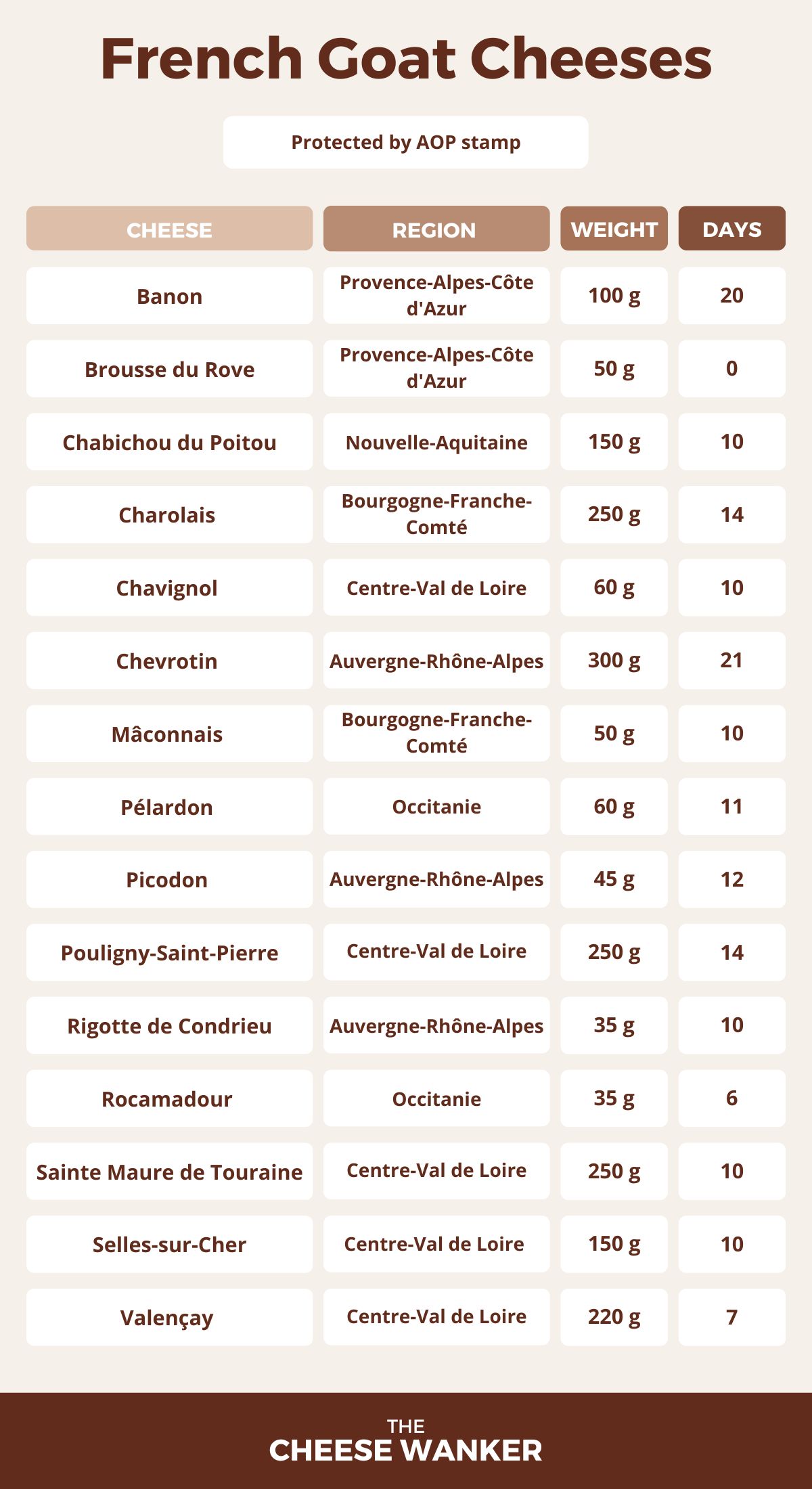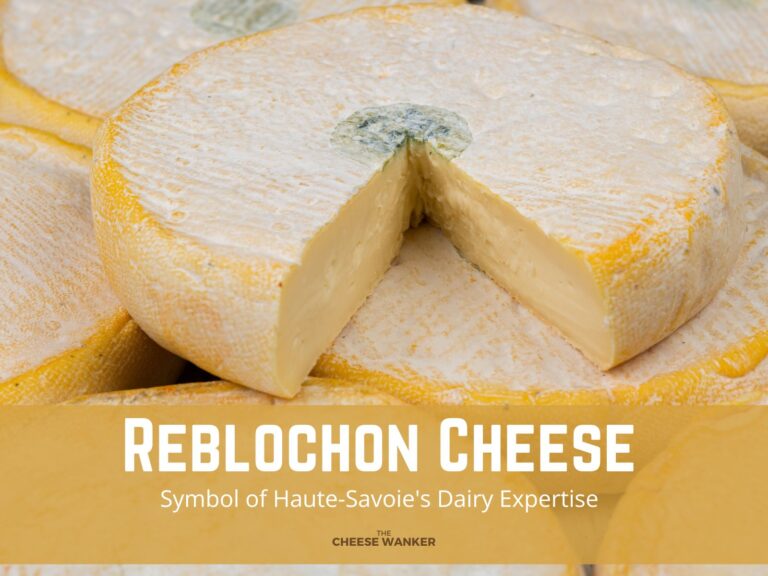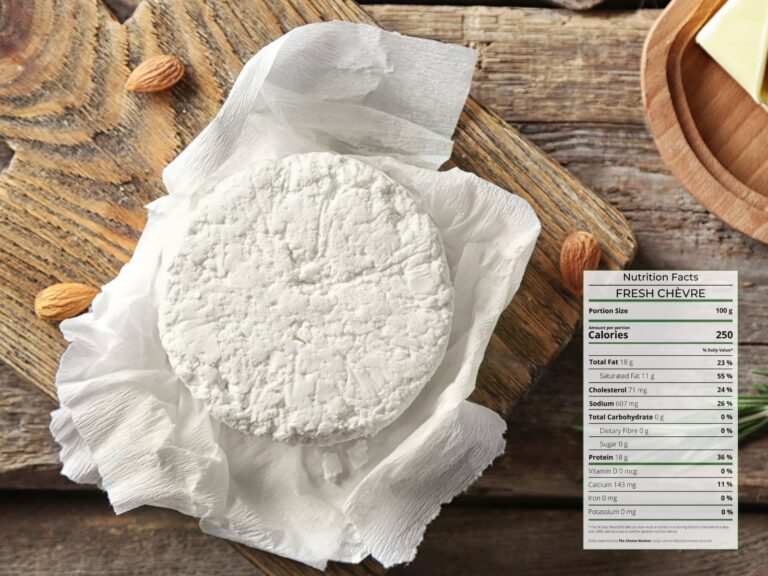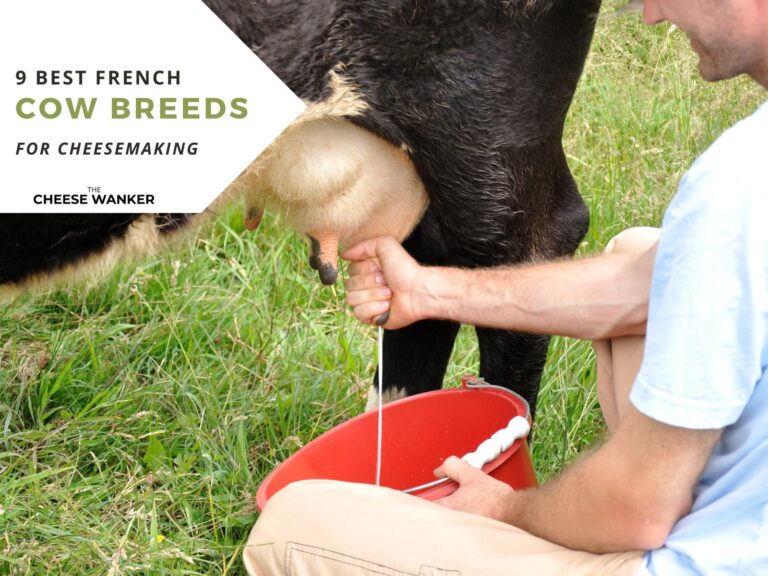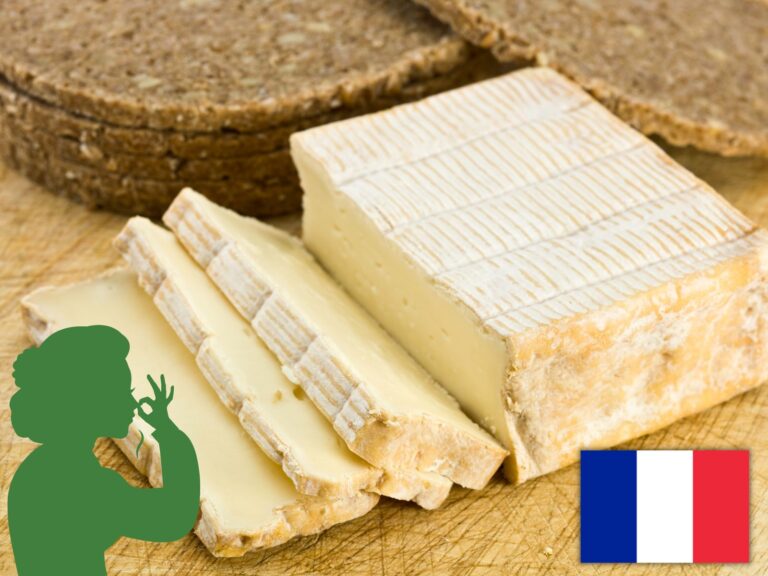When it comes to goat cheese, France is renowned for its exceptional variety and quality. With a long history of craftsmanship, France produces an impressive array of artisanal goat cheeses. In this article, we will delve into the captivating world of these unique cheeses. So, prepare your taste buds for a delightful journey as we discover the best goat cheeses from France.
SEE ALSO: The Cheese Wanker’s ultimate guide to goat cheeses →
History of goat cheese in France
The tradition of goat cheese making in France can be traced back centuries. From ancient times, goats were well-suited to the country’s diverse terrains, thriving in the rocky hillsides, mountains and lush pastures.
Farmers, recognizing the value of goat’s milk, began crafting cheeses as a means of preserving and utilising this precious resource. Over time, this practice evolved into a cherished art form, where local knowledge and time-honoured techniques passed down through generations shaped the character of these remarkable cheeses.
Goat cheese regions in France
France’s goat cheesemaking prowess is closely tied to specific regions that possess favourable conditions for raising goats and producing exceptional milk. Several key areas have emerged as the backbone of goat cheese production.
- Auvergne-Rhône-Alpes: Known for its diverse landscape and traditional cheesemaking techniques, Auvergne-Rhône-Alpes produces a variety of goat cheeses, including the famous Picodon, with its distinct flavour and creamy texture.
- Bourgogne-France-Comté: This region is renowned for its goat cheeses such as Charolais, made from raw goat’s milk, and Mâconnais.
- Centre-Val de Loire: With its rich agricultural heritage, Centre-Val de Loire is home to renowned goat cheeses like Valençay, known for its unique truncated pyramid shape and an ash-coated rind.
- Nouvelle-Aquitaine: As one of the largest regions in France, Nouvelle-Aquitaine covers the historical region of Poitou-Charentes which is a hub of goat cheesemaking.
- Occitanie: This region offers a variety of goat cheeses, such as the tiny Rocamadour and Pélardon, known for its delicate taste and crumbly texture.
- Provence-Alpes-Côte d’Azur: Known for its Mediterranean climate, this region produces two AOP goat cheeses, Banon and Brousse du Rove.
Each region brings its own distinct flavour profiles and traditions, resulting in a captivating tapestry of tastes that exemplify the diversity of France’s goat cheeses.
France’s 15 best goat cheeses
While there are countless versions of artisanal goat cheeses made around the country, we want to focus on the 15 French goat cheeses that bear an AOP stamp. You can read more about how the AOP protects cheese and other foods in our post here.
Let’s have a look at France’s AOP goat cheese in alphabetical order.
Banon (Provence-Alpes-Côte d’Azur)
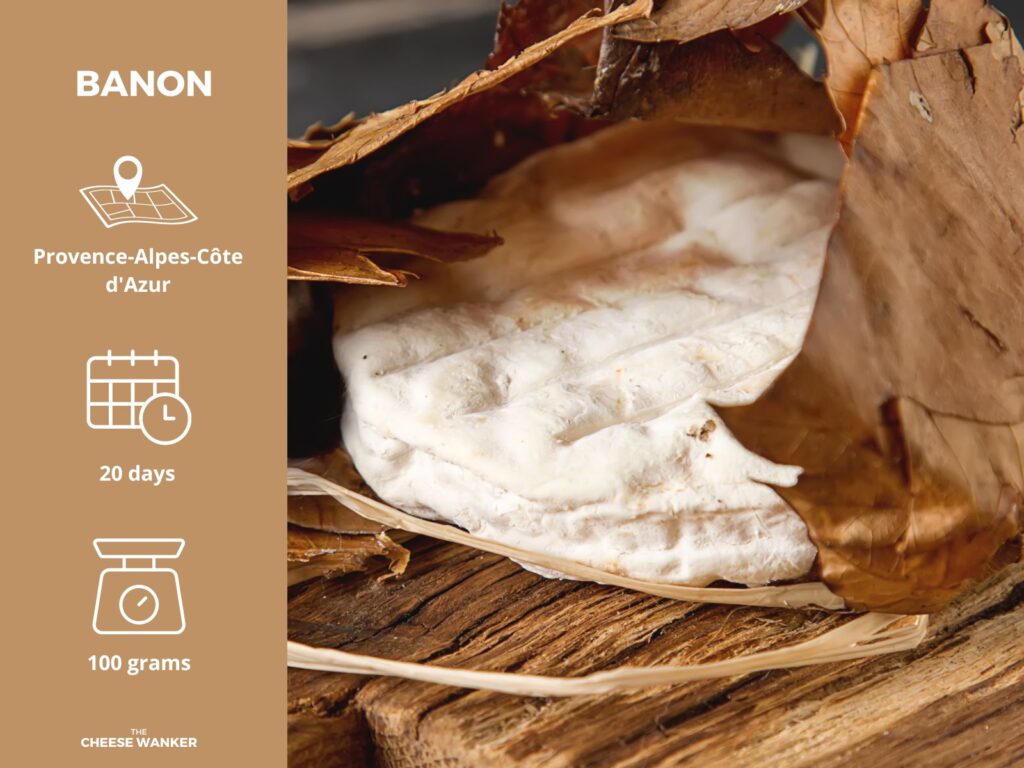
The first cheese on our list is undoubtedly one of the most aesthetic ones. Banon is a small round cheese, featuring a creamy or golden-brown rind. Weighing around 100 g, this cheese has a soft and creamy texture. And its mild flavour is elevated by the infusion of tannins from chestnut leaves used to wrap it.
Made from raw whole milk, Banon cheese undergoes a minimum ageing period of 20 days, resulting in a delightful culinary experience. You can read more about why raw milk is so important in cheesemaking in our dedicated post.
Without a doubt, Banon excels on a cheese board with green olives and a glass of a local fruity white wine.
Brousse du Rove (Provence-Alpes-Côte d’Azur)
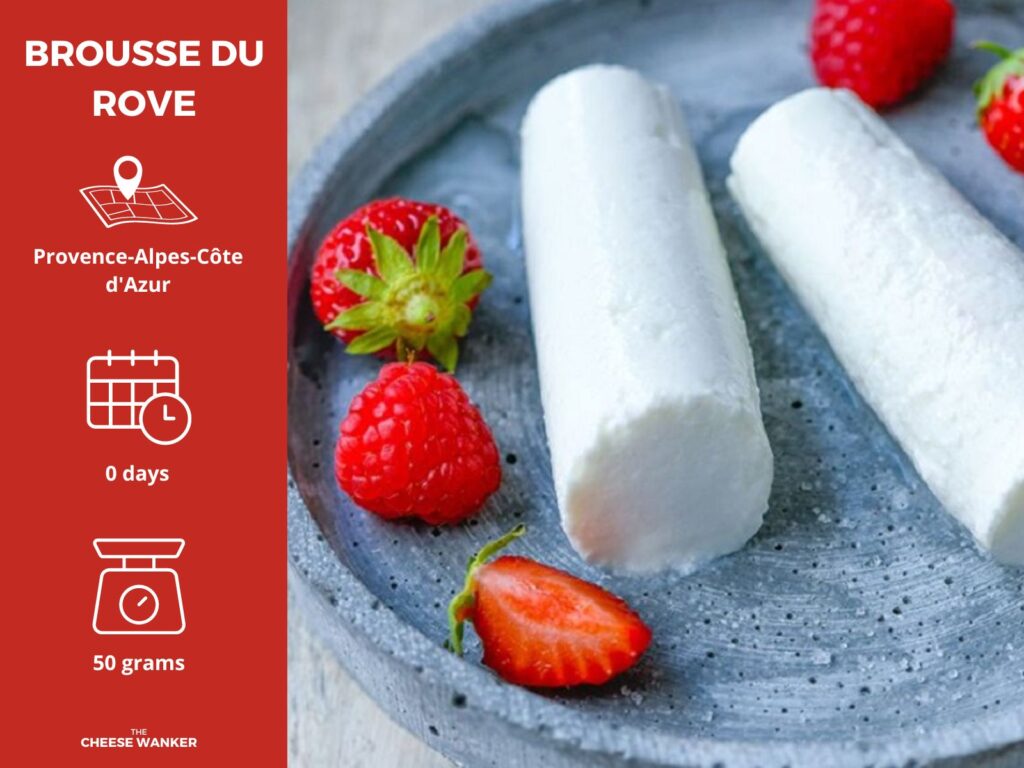
Next, we have Brousse du Rove. This fresh rindless cheese has a creamy and crumbly white paste. Its texture is light and moist, and its taste mild and neutral, allowing secondary flavours to shine.
Made from raw milk and a touch of white alcohol vinegar, it is stirred until curdling occurs. This cheese does not require any ageing, making it a delightful choice for immediate enjoyment. Moreover, Brousse du Rove has the double distinction of being France’s most recent AOP cheese and the only unsalted one!
Traditionally enjoyed as a dessert with a sprinkle of sugar, Brousse also pairs well with honey, maple syrup and fresh fruits like strawberries. You can also add this fresh unsalted cheese to savoury recipes such as omelettes and pair it with cooked artichokes, tomatoes and beets.
Chabichou du Poitou (Nouvelle-Aquitaine)
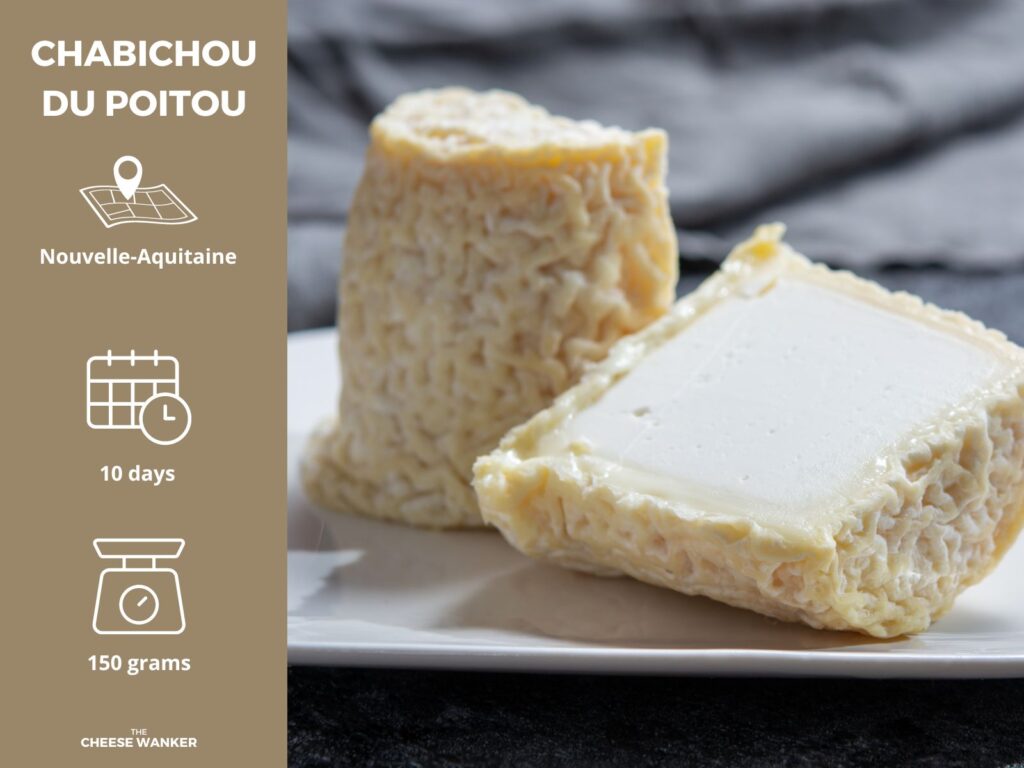
This cheese might just have the cutest name of them all! Chabichou du Poitou is a visually striking cheese, shaped like a slightly bulging cylinder with a wrinkly Geotrichum rind. Its texture is a delightful balance between a creamy, melt-in-your-mouth consistency and a dry, brittle texture when cut.
The cheese offers a range of flavours, from the fragrance of fresh cream to the earthy essence of autumn undergrowth, creating a harmonious and nuanced taste experience. After a minimum ageing period of 10 days, the cheese is ready to be enjoyed, showcasing the dedication and craftsmanship involved in its production.
The locals enjoy this iconic cheese with roasted chestnuts, caramelised onions or even in a hearty curry.
Charolais (Bourgogne-Franche-Comté)
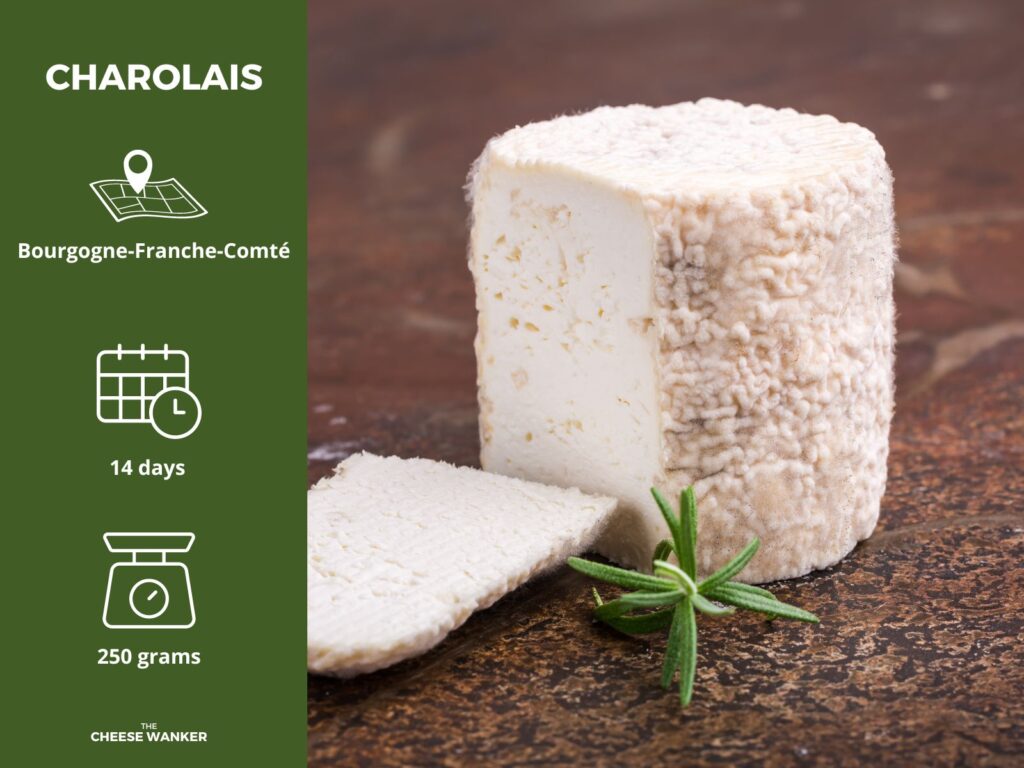
Our next goat cheese is Charolais. This traditional cheese has a barrel shape and a white downy rind that evolves into a blue hue. It has a soft, tender and creamy white paste, offering a delightful texture. The taste of Charolais cheese starts with a mild aroma when fresh, which intensifies and becomes more assertive with age, creating a range of flavours to enjoy.
Made from raw milk, it undergoes a short maturation period and is carefully moulded, salted and aged to perfection on racks. With a minimum ageing duration of 2 weeks, Charolais cheese is a true delight for cheese enthusiasts seeking a unique and flavourful experience.
This versatile goat cheese can be enjoyed in a fresh rocket (arugula) salad or melted on grilled cèpes mushrooms.
Chavignol (Centre-Val de Loire)
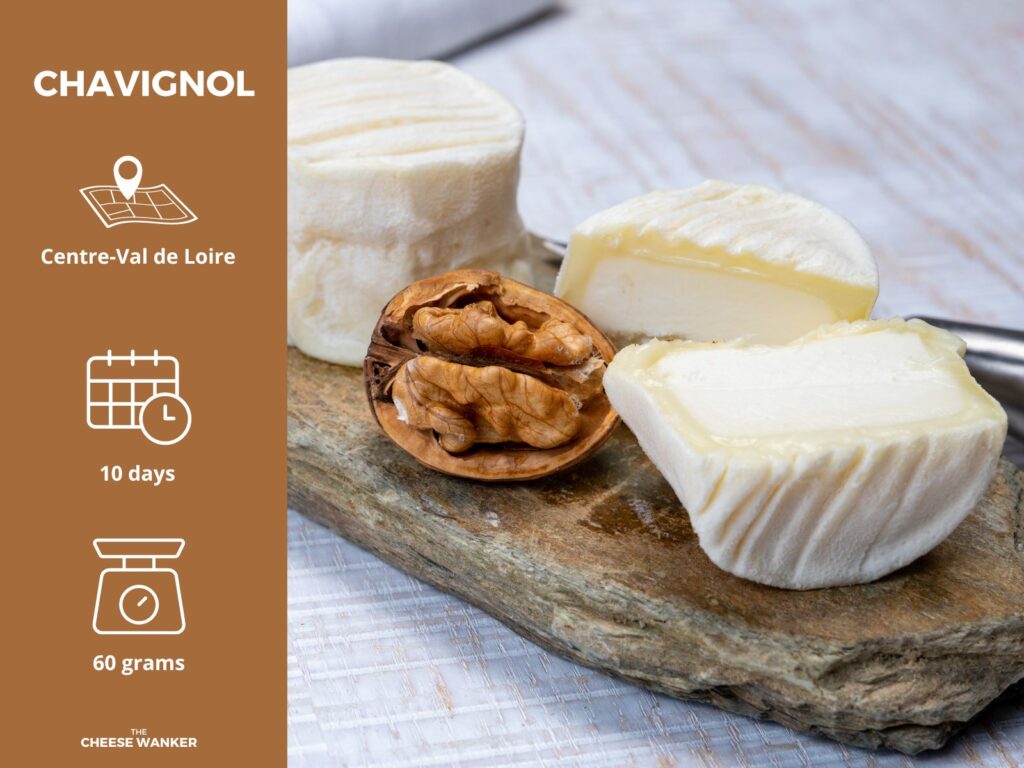
Chavignol is another cylindrical goat cheese with rounded edges. It features a natural, thin and bloomy rind, adding to its aesthetic appeal. The texture of Chavignol varies from the rind to its centre. As a result, its mouthfeel ranges from creamy and melting (near the rind) to dry and chalky (in the core).
When it comes to taste, Chavignol delivers a delightful sensory journey, with its aroma varying from the scent of fresh cream to the earthy undertones reminiscent of autumn forests. Crafted from raw milk, this cheese undergoes a minimum ageing period of 10 days, allowing its flavours to develop and mature into a truly remarkable culinary delight.
Some great serving suggestions for Chavignol include toasting on a baguette, pairing with fresh grapes and spread on gingerbread.
Chevrotin (Auvergne-Rhône-Alpes)
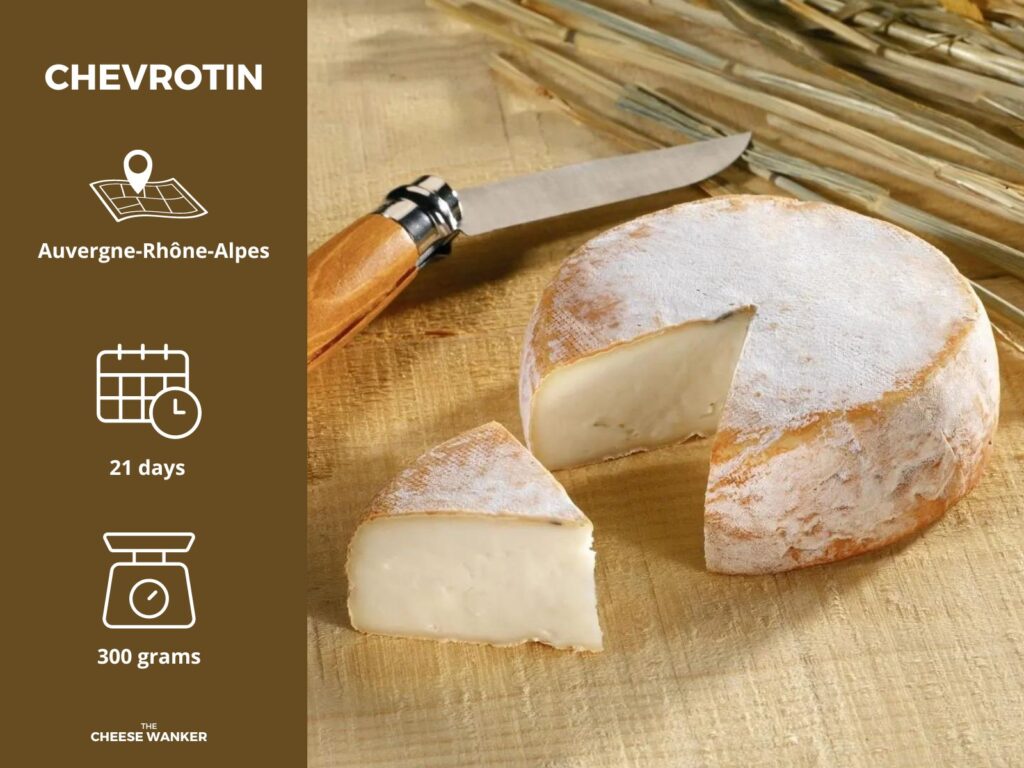
Often described as a goat milk Reblochon, Chevrotin has a flat round shape and a washed rind that ranges in colour from pink to orange. Its texture is creamy, smooth and soft, crafting a delightful mouthfeel.
The taste of Chevrotin starts subtly and develops into a more distinct and characteristic flavour as it ages. It is exclusively handmade on farms using raw milk and undergoes a minimum ageing period of 3 weeks.
Just like Reblochon, Chevrotin excels when melted in Tartiflette, a grilled cheese sandwich or on top of your favourite pasta.
Mâconnais (Bourgogne-Franche-Comté)
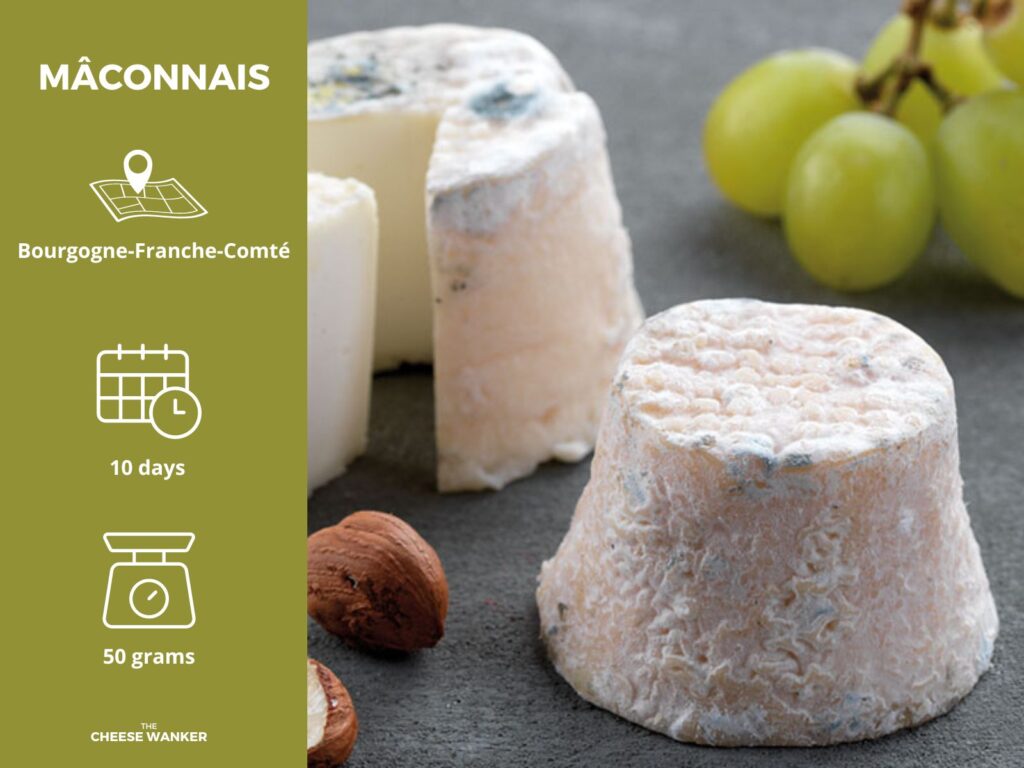
Our second cheese from Bourgogne-Franche-Comté is Mâconnais. This small cheese weighs 50 g and has a conical shape with a soft and creamy paste. Overall, it offers a slightly savoury flavour that evolves and intensifies with maturation, providing a diverse range of taste sensations.
Crafted using traditional methods, Mâconnais is exclusively a farmhouse cheese. You can read more about farmhouse cheeses in our dedicated post here. Its compact size and delightful flavour make Mâconnais a true delight for cheese enthusiasts seeking a unique and enjoyable culinary experience.
This small AOP cheese can be served grated on top of pumpkin soup or fresh in a forest berry salad.
Pélardon (Occitanie)
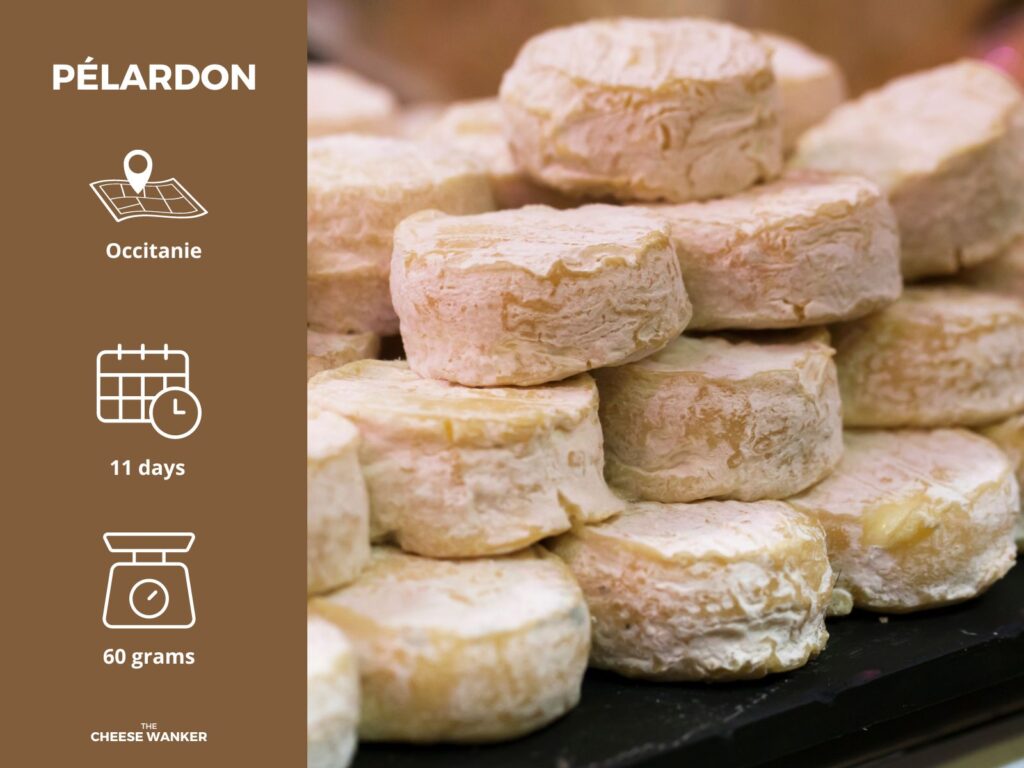
Next, we venture into Occitanie to discover Pélardon. This goat cheese has a flat cylindrical shape with a thin, wrinkly rind. On the surface, you will find hues of cream, pale yellow, white and blue. Underneath, it has an ivory-white paste and a delightful taste with a subtle hint of hazelnut.
Made from fresh raw milk, Pélardon undergoes a minimum ageing period of 11 days, resulting in a unique and enjoyable cheese experience for cheese enthusiasts. As it matures, the flavour becomes more pronounced without sacrificing its finesse.
Unsurprisingly, this cheese is complex enough to be enjoyed fresh on a cheese board with a slice of pickled lemon. Also, it pairs well with medium-bodied red wines or dry ciders.
Picodon (Auvergne-Rhône-Alpes)
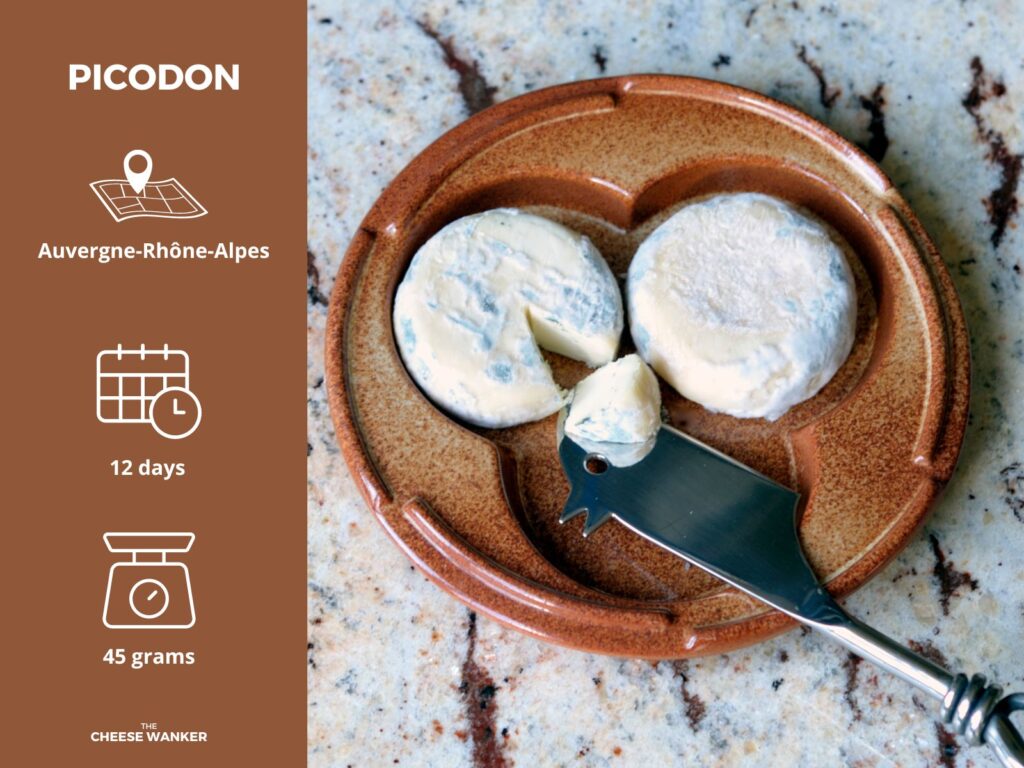
And we’re back in Auvergne-Rhône-Alpes to discover Picodon. This small, rounded soft goat cheese has a natural rind and a firm paste. As it ages, its texture becomes crumblier and its flavour more pronounced.
Picodon requires a minimum ageing period of 12 days to fully develop its unique organoleptic properties. With its rich, nutty flavour and crumbly texture, this cheese has become a regional favourite.
You can enjoy it fresh with sliced zucchini (courgette) and black olives or melted on a focaccia. In addition to this, Picodon pairs well with fruity red wines or robust beers.
Pouligny-Saint-Pierre (Centre-Val de Loire)
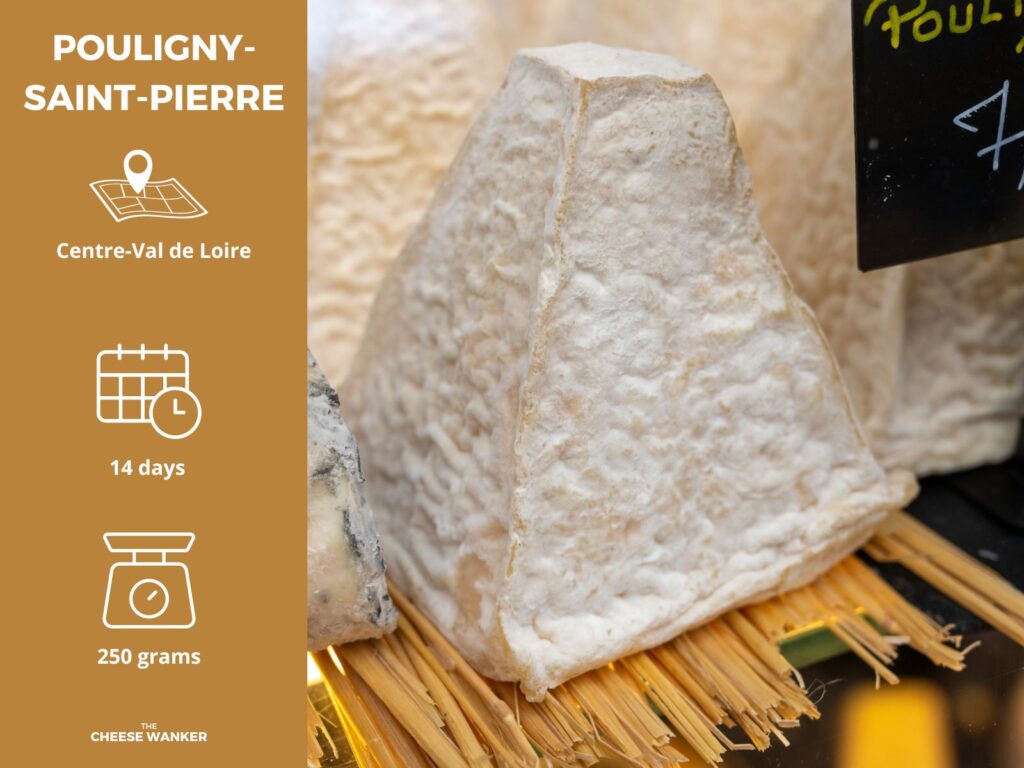
The first pyramid-shaped cheese on our list is Pouligny-Saint-Pierre. Actually, this was the first French goat cheese to earn an AOC stamp (precursor to the AOP) in 1972. Made from raw whole milk, the cheese undergoes a minimum ageing period of two weeks.
This iconic French goat cheese has a bloomy white rind with blue mould patches. Furthermore, it has a firm yet supple texture and offers a wide range of flavours, from delicate to pronounced, with hints of hazelnut.
Without a doubt, this goat cheese is best served fresh on a cheese platter. Pair it with smoked salmon or a lavender honey. And pour yourself a glass of a crisp white wine or fruity red.
Rigotte de Condrieu (Auvergne-Rhône-Alpes)
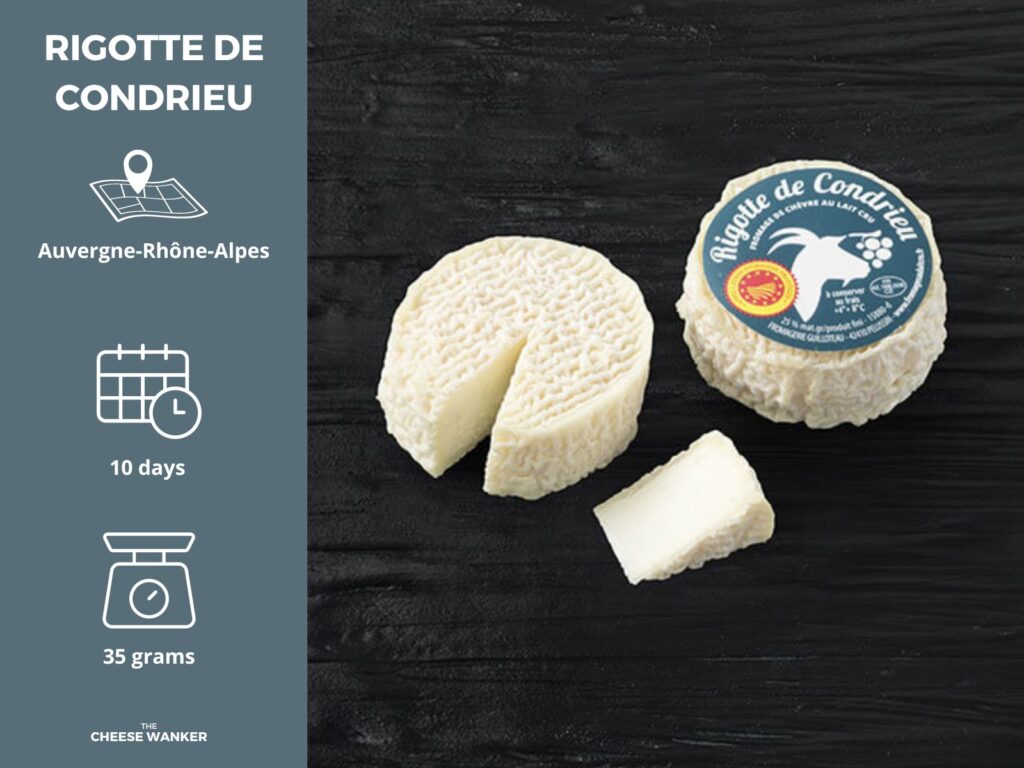
The next two cheeses on our list are the joined smallest AOP cheeses in France. Weighing in at 35 g, Rigotte de Condrieu is a flat cylindrical cheese with an irregular ivory rind. Made from raw goat’s milk, it has a soft and melting texture that reveals delicate flavours of hazelnut.
Produced through lactic coagulation, this cheese undergoes a minimum ageing period of around 10 days, allowing it to develop its unique taste profile. Rigotte de Condrieu is a delightful cheese choice for those who appreciate the creamy texture and subtle, nutty flavours of goat’s milk cheese.
You can serve this tiny goat cheese fresh on a cheese platter or sliced in a sandwich. In addition to this, it is a great choice for Chèvre Chaud, a classic French warm goat cheese salad.
Rocamadour (Occitanie)
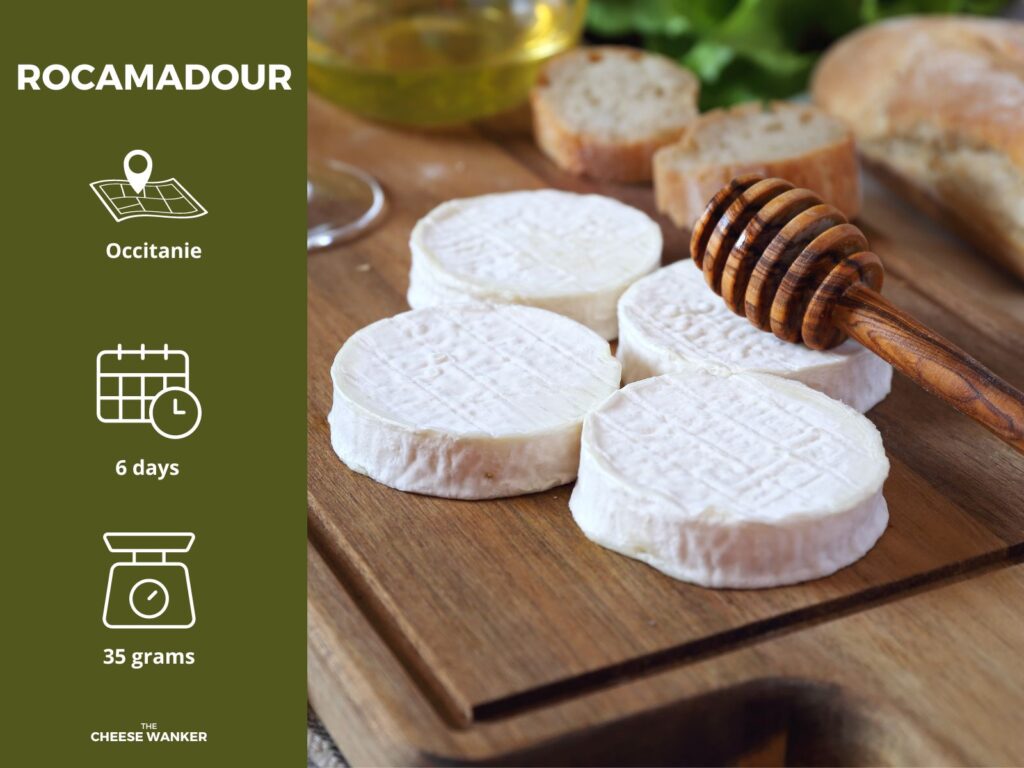
Also weighing in at 35 g, we have Occitanie’s second AOP goat cheese, Rocamadour. This tiny goat cheese is a flat disc with a white, ivory or dark beige rind. It has a soft and creamy texture, delivering a distinctive goat flavour.
Made from raw whole milk, the cheese undergoes a lactose coagulation process before ageing in a ripening cellar or cave. According to the AOP, maturation lasts for a minimum of 6 days to develop its unique taste and qualities.
Similarly to Rigotte de Condrieu, this small goat cheese is the perfect ingredient for a Chèvre Chaud. In addition to this, Rocamadour is an excellent butter substitute on a warm crunchy baguette.
Sainte Maure de Touraine (Centre-Val de Loire)
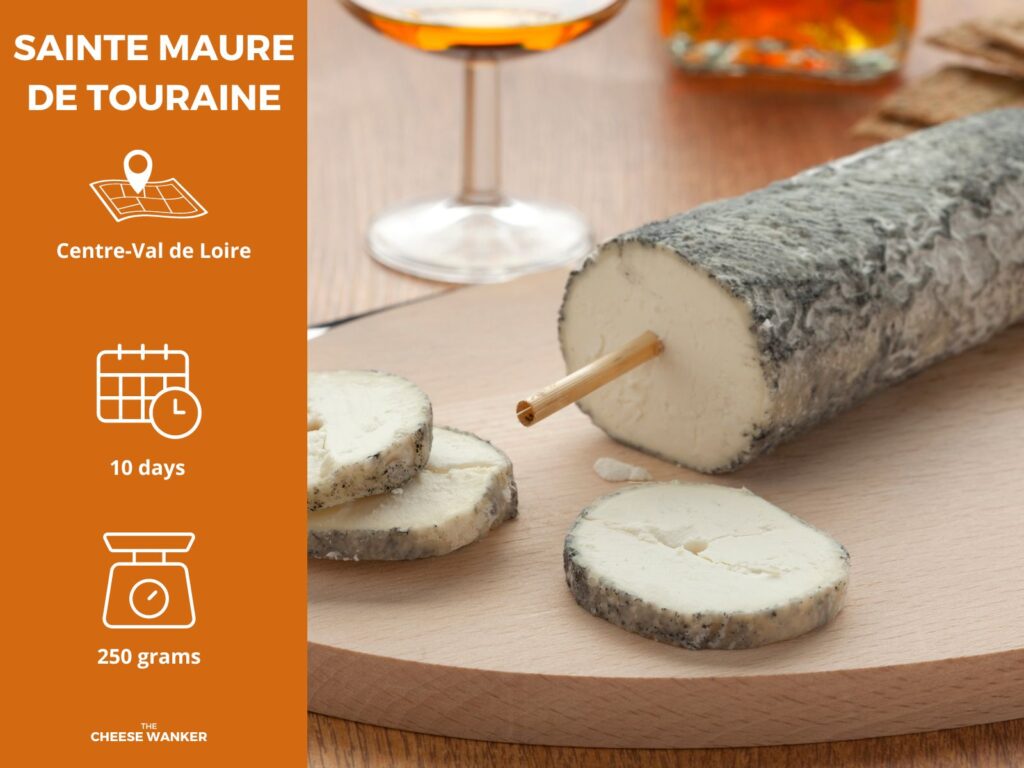
Named after its place of origin, Sainte Maure de Touraine is log-shaped and features a wrinkly natural rind. And it is traditionally adorned with a rye straw bearing the printed designation name as a symbol of its authenticity. This straw not only helps maintain the delicate shape of the cheese but also prevents it from breaking.
After ageing for 10 days, the ash-covered surface of Sainte Maure de Touraine develops a wrinkly appearance, adorned with grey and blue mould. The interior showcases a thin creamy layer adjacent to the rind, while the centre remains firm and strikingly white.
This gorgeous goat log will look spectacular on a cheese board. Having said that, you can also slice it and melt on top of grilled seasonal mushrooms. Wash it all down with a Sauvignon Blanc or light red wine.
Selles-sur-Cher (Centre-Val de Loire)
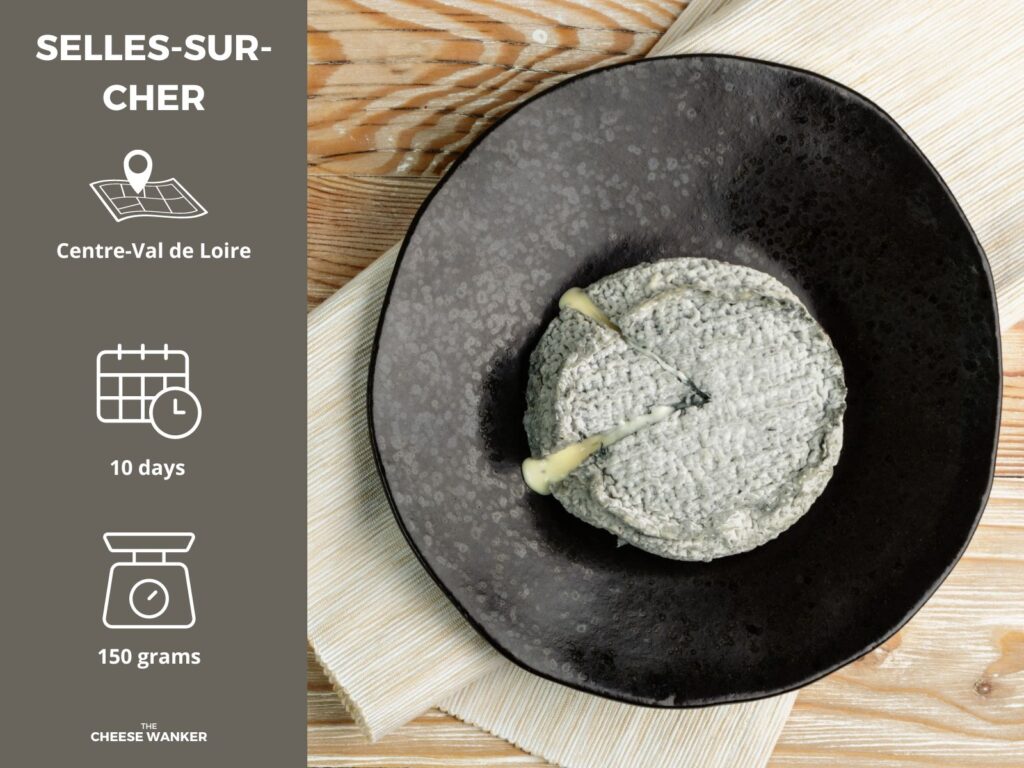
Another ashed cheese on our list is Selles-sur-Cher. Originally crafted for family consumption, the roots of this cheese can be traced back to the 19th century when it was named after its main production and commercial hub, Selles-sur-Cher.
Made from whole goat’s milk, this cheese is coated in a distinctive layer of ash. The minimum maturation period for Selles-sur-Cher is 10 days. At this age, the cheese develops a thin, powdery grey rind and a bright white, dense and slightly moist paste.
Selles-sur-Cher is at its best during spring, and you will augment its flavour and texture by pairing with green peas and spinach. Some other options include roasted peanuts, apple jam and dried nuts.
Valençay (Centre-Val de Loire)
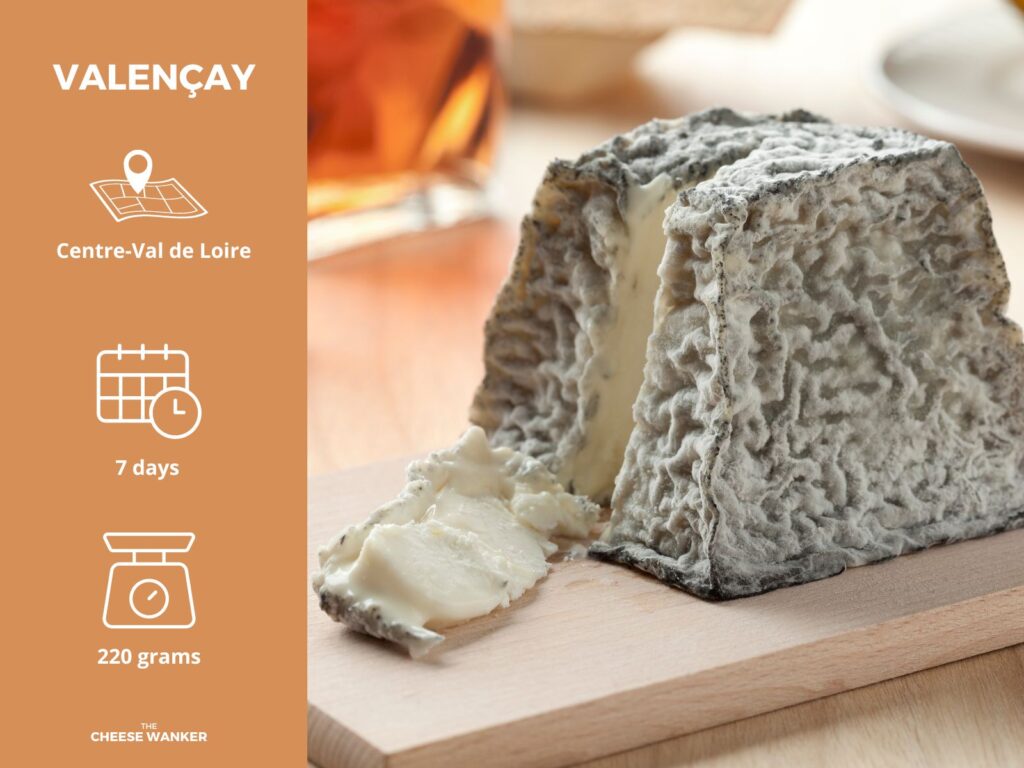
Finally, we’ve got the fifth cheese from Centre-Val de Loire and second truncated pyramid cheese on our list. Valençay features a fine and bloomy rind in shades of light grey to bluish grey. It has a soft, white, and smooth paste, offering a long and creamy taste with hints of undergrowth, hazelnut and floral nuances.
Made from raw milk, the cheese undergoes a 24 to 36-hour coagulation process, followed by salting with ash-covered salt. It requires a minimum ageing period of 7 days to develop its distinctive flavours and characteristics.
Given the cheese’s aesthetic and complex flavour, it would be sinful to do anything other than serve it on a cheese platter. As for pairings, go for fresh pear or pear juice, lavender honey or piquillo chilli jam.
Beyond the AOP (notable mentions)
While France only has 15 AOP goat cheeses, there are many more iconic French cheeses made with goat milk. A few that are worth a mention include:
- Cabécou: small format soft cheese (40 g) that originates from the Périgord region.
- Mothais Sur Feuille: soft white mould goat cheese from Poitou-Charentes that is wrapped in a chestnut leaf.
- Persillé de Rambouillet: goat’s milk blue cheese originating from a small farm in the Ile-de-France region of France.
- Tomme de Chèvre: mountain cheese from Savoie that is reminiscent of the iconic Tomme de Savoie
Summary: A goat cheese heritage
France’s 15 AOP goat cheeses are a testament to the country’s rich cheesemaking heritage and diverse landscapes. As you embark on your culinary journey through these exquisite cheeses, don’t hesitate to explore the suggested pairings and experiment with different flavours.
Whether you’re a seasoned cheese connoisseur or a curious food lover, let the flavours of France’s AOP goat cheeses transport you to a world of gastronomic delights.
What’s your favourite French goat cheese? Let us know in the comments below.
